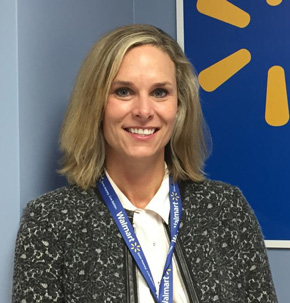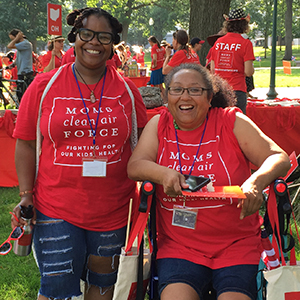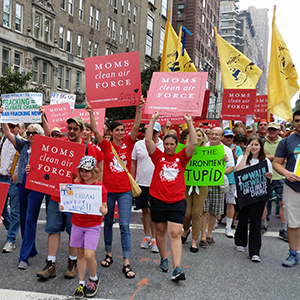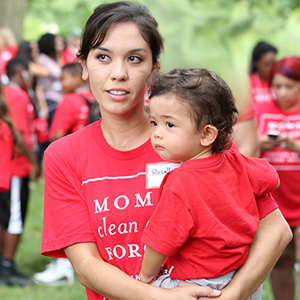Walmart is not just a superstore, it’s the tenth largest economic entity in the world, slightly larger than the economy of Spain. So when Walmart recently announced its commitment to help reduce the carbon dioxide emissions of its suppliers by one billion metric tons, it placed the company among the ranks of global economies taking major climate action.

Laura Phillips, senior vice president of sustainability at Walmart, is one of the chief architects of this and other company sustainability efforts. A 22-year veteran of Walmart, Laura brings to her work not only deep corporate experience, but also her experience of being a mom to a ten-year-old and a 13-year-old. She also cares for two dogs, a cat, a hamster, and a horse at her Arkansas home.
Moms Clean Air Force recently spoke with Laura about Walmart’s efforts to improve its sustainability.
Moms Clean Air Force: What is your role with Walmart?
Laura Phillips: I lead our global sustainability efforts. We work on sustainability across the globe in all of our markets and in all areas of our business. We develop strategies for the company as well as some of the metrics and systems and processes to carry them out.
What does sustainability mean to Walmart?
We started to do work in this space about ten years ago. What we learned was that there was a lot we can do for the environment that’s also good for our business and good for our customers. When we think about sustainability it’s really about driving change that helps us to sustain our business as well as the communities, the customers, and the people that are dependent on us and that we depend on.
How does being a mother impact your work?
My two kids are very aware of environmental issues. They learn about it in school and care deeply about what’s happening in the environment. They want to know, what are we doing about it as their parents? They also want to know what Walmart is doing about it as a business. It’s a regular conversation in my house around issues like recycling, animal welfare, and water and air quality. They hold me accountable for making sure we are doing the work.
Does your work in sustainability change the way that you parent? Have you brought home any of the lessons that you are learning at work?
Once you learn about some of these issues and challenges, it’s hard not to be personally motivated to do your part. I feel that as well. One that has been on my mind recently is food waste. In our house, to be honest, we hadn’t been paying attention to it. But the more I worked on it in the business and really understood it and really saw the challenges there, I’ve brought that one home and we are definitely starting to be more aware about that one.
Talk about Walmart’s initiatives to protect children from toxic chemicals.
Several years ago we started to identify high priority chemicals and begin to remove them with our suppliers. We targeted products in the personal care and cleaning categories, and we worked with our suppliers to reduce those high priority chemicals and replace them with products that are just as effective but don’t have those same health concerns. Last July, we announced that we achieved a 95% reduction by weight of those initial chemicals that we were targeting. That’s a big step, but there’s more to do. This is something that is really important to our customers.
What is Project Gigaton?
Walmart has made commitments to reducing our carbon dioxide emissions for more than ten years and we have delivered a lot of good results through that. We are now at about 25% renewable energy in our own operations, and we’ve worked hard also on our energy intensity in our stores and clubs and facilities around the world. We are starting to now take that into our supply chain and work with our suppliers to challenge them on what they’re doing to reduce emissions in the products that they sell to us.
We looked at key areas in our stores like energy efficiency, renewable energy, food waste, deforestation, and agriculture. But what if we got more suppliers participating in these kinds of programs? What if we took our suppliers and asked them to make a similar commitment to what we are already doing internally? When we added those things together, and looked at that cumulative impact through 2030 – we realized that the total potential reductions adds up to about a gigaton.*
So that’s our challenge to our suppliers. We are challenging them to sign up alongside Walmart in reducing emissions by one gigaton.
A gigaton* is actually possible?
Yes. We have done the math and we know which suppliers to call. We are talking to them. We also know what activities and projects can have the largest impact. Agriculture is a big one. We have lots of work that we can do together with our suppliers on this. If we use less fertilizer, for example, on row crops and cereals, that’s good for the climate and it’s also good for water quality.
Do you have advice for moms who are interested in reducing the carbon emissions of their family?
Always shop at Walmart! Just kidding… But actually, we just completed some work on this and it turns out that going to a one stop shop on your way home from work and buying everything you can there, is a really efficient way to shop.
When you inform moms and challenge them to think about issues and make small changes of their own in their own household, and then to talk to their children about it – I think it’s just great. There’s so many small changes that we can make that can really help make a difference for future generations.
* A gigaton is one billion tons of carbon dioxide – the equivalent of one year’s emissions from more than 211 million cars.
TELL YOUR SENATOR: PROTECT OUR HEALTH FROM AIR AND CLIMATE POLLUTION




